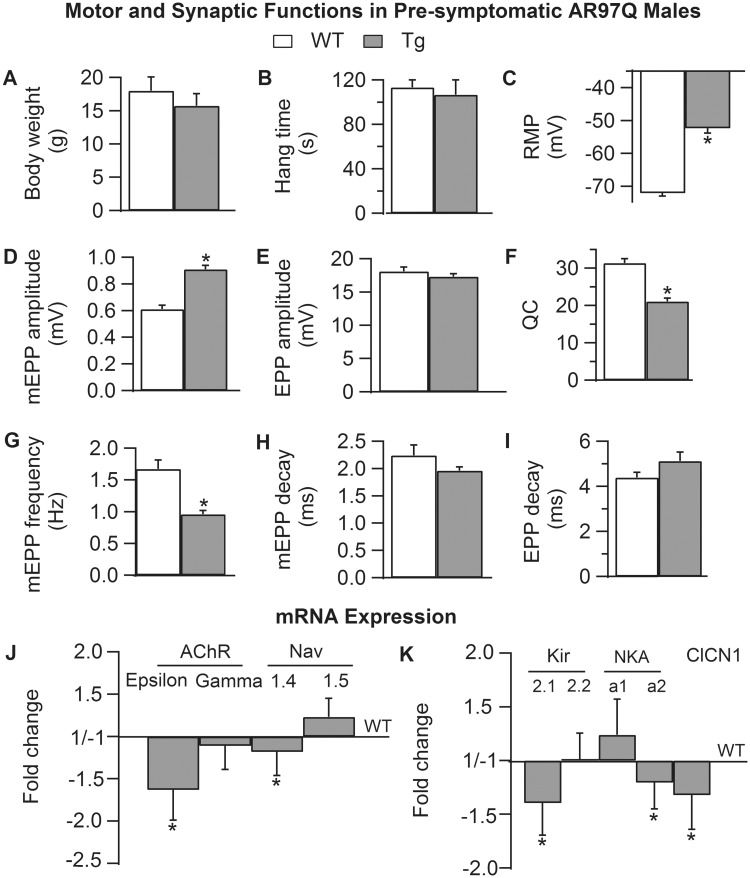Figure 3.
Neuromuscular synapses are defective in pre-symptomatic AR97Q males. (A and B) Body weight and motor function based on hang time is normal in 33- to 40-day-old AR97Q males. (C) However, the RMP of muscle fibers of pre-symptomatic Tg males is already significantly depolarized compared with age-matched WT males, comparable with that of late-stage diseased Tg males (Fig. 1). We also find that quantal size (mEPP amplitude) is significantly larger than normal (D) but EPP amplitude is not similarly affected (E), causing a significant deficit in QC (F) in pre-symptomatic males, also comparable with late-stage, motor impaired AR97Q males (Fig. 1). (G) Spontaneous release of transmitter (mEPP frequency) is also significantly decreased in pre-symptomatic AR97Q mice compared with WT males. (H and I) Unlike diseased adults, the decay time of mEPPs and EPPs is not altered in pre-symptomatic AR97Q NMJs. (J and K) Quantitative (q) PCR revealed that the expression of several critical genes is perturbed in muscle of pre-symptomatic AR97Q males, despite the lack of detectable motor dysfunction. Expression of the embryonic AChR γ-subunit is normal in Tg mice, as expected given the normal decay time of synaptic potentials. However, mRNA for the adult ε-subunit is significantly decreased, indicating an effect of disease already on this measure (J). Likewise, expression of the adult isoform of the sodium channel (Nav1.4) is significantly reduced, as in late-stage muscle, but without the increase in mRNA for the neonatal isoform (Nav1.5) that eventually renders diseased fiber in AR97Q adults appreciably less sensitive to µ-CTX. Expression of the adult isoform of the chloride channel is significantly decreased in pre-symptomatic AR97Q males (K), comparable with late-stage muscle. As expected based on the ∼20 mV depolarizing shift in the RMP, we find defects in the expression of both the inward rectifier potassium channel (Kir2) and the sodium/potassium pump (NKA), two critical determinants of the RMP of skeletal muscle fibers. Both Kir2.1 and NKA α2 mRNAs are significantly downregulated in muscle of pre-symptomatic AR97Q males, whereas Kir2.2 and NKA a1 mRNA levels are unaltered. These data identify several putative pre-clinical markers of disease that represent novel therapeutic targets for halting disease before irreparable damage is done. Findings also begin to characterize the sequelae of pathogenic events that underlie the progressive loss of motor ability. For example, loss of adult isoforms evidently precede, and possibly trigger, the upregulation of neonatal isoforms. A–I: Values plotted are group means (N for motor function and n for synaptic function) ± SEM (WT: n/N = 42/4; pre-symptomatic AR97Q: n/N = 42/4) normalized to WT values with n indicating the number of endplates/mice and N the number of mice per experimental group from the fast twitch EDL muscle. J and K: Values are mean fold changes ± SEMs based on N/group (AR97Q: N = 6; WT: N = 8) from the fast twitch anterior tibialis muscle. *P < 0.05 from WT.

